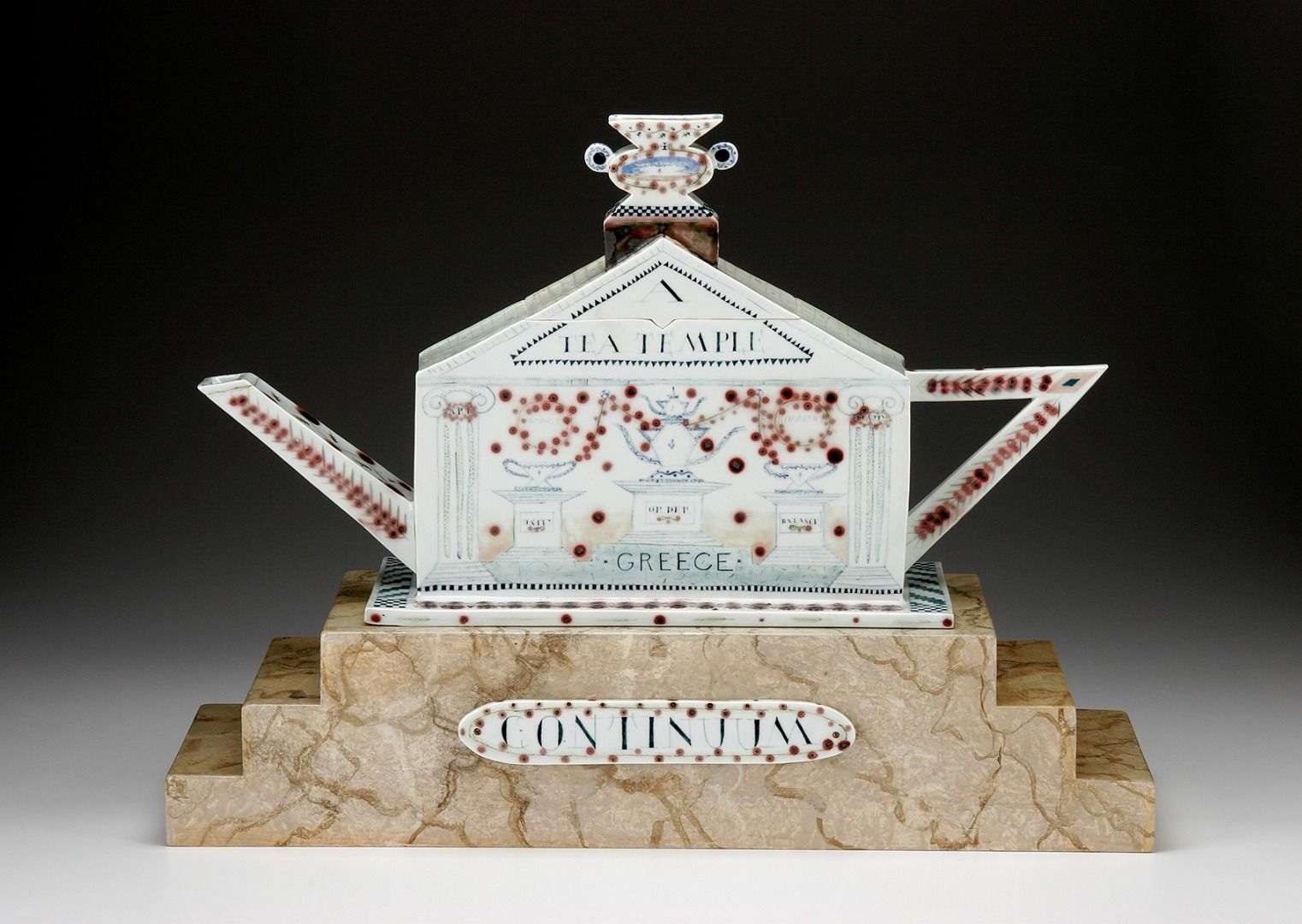Mara Superior (b. 1951) wields her knowledge of art history and historical decorative traditions to engage with the present day through her porcelain sculptures. Superior references history by using the traditional forms of relief platters, teapots, and other domestic, decorative items, which she decorates with contemporary textual commentary. Explaining her work, Superior has said, “I seek to create beauty through the reinterpretation of historical inspirations synthesized with my own visual vocabulary and contemporary views. The resulting objects are rooted in the historical continuum.” Superior was born in New York City and she has spent the majority of her life living in Western Massachusetts. In the 1970s, Superior attended several universities to study and practice art, including the Hartford Art School at the University of Hartford (1970–71), the University of Connecticut (BFA 1975), as well as the University of Massachusetts, Amherst, where she earned a Master of Arts in Teaching (MAT) in Ceramics in 1980. Superior credits her family and art teachers’ encouragement and care for supporting her artistic development, as well as the support and partnership she shared with her late husband, Roy Superior. Mara Superior met Roy at Hampshire College, where the pair shared studios. They founded Pinch Pottery in Northampton and later East Street Clay Studios in Hadley, Massachusetts. Roy, an artist and professor himself, worked with Mara to renovate their New England farmhouse, where Mara still resides today. Their partnership lasted for four decades, until Roy passed away in 2013. While Superior credits past teachers and her family for encouragement, her work is wholly her own. A voracious museumgoer, Superior cites her expansive travel experience and historical research for inspiring her ceramic works. She works with porcelain, using the milky white surface as a base for delicate, painterly decorations. Porcelain is notoriously difficult to work with, and Superior increases the difficulty of an already fussy material by hand building. Porcelain can easily become “fatigued” through handling, so an artist must be swift and economic with engaging the material. Porcelain is a thirsty clay, absorbing water quickly, which makes the material more likely to collapse. It can also easily crack. Superior deftly overcomes these challenges and continues to create increasingly intricate designs as her career progresses. These choices, along with her adoption of teapots and decorative ceramic forms, often lead viewers to associate her work with femininity. Superior, herself a feminist, embraces this association, noting “The choices that I employ regarding my own work for materials, content, palette and ornament might, by historical standards, be considered feminine work by nature. That label has never been a hindrance to me.” The Everson acquired Tea Temple Teapot in 2016 as a gift from the Kohler Foundation, and it exemplifies Superior’s playful mix of historic forms and aesthetics with the modern day. The sculpture is, as the title implies, a teapot, although Superior transforms the teapot’s form into something more architectural. The teapot sits on a tiered base reminiscent of marble, with its spout and handle jutting out at sharp angles. The teapot’s body resembles architectural elements, its shape simplified to a rectangle topped by a triangle, mimicking the traditional shapes of an ancient Greek temple, complete with Ionic columns. Superior teases her audience by adding evocative words to the teapot’s surface, further blurring the lines of what her art is and isn’t. Her use of “CONTINUUM” on the faux marble base has a dual purpose: Superior uses the word to speak to the long trajectory of art history, of which she is both a contributor and connoisseur, yet she also plays with the word’s roots, referencing the Latin word “contineō” which means to contain or enclose. Thus, Superior places herself and her teapot within the scope of art history, even as she teases that the teapot is a functional “container.” A usable teapot blurring into ancient architecture, a historic heirloom made in 1998—Superior’s Tea Temple Teapot is a complex work of art. Tea Temple Teapot, currently on display in A Legacy of Firsts: The Everson Collects.
—Kelli Fisher, Curatorial Intern
Sources:1. Badenhorst, Antoinette. “Porcelain for Beginners—8 Tips for Getting Off to a Good Start with Porcelain.” Ceramic Arts Network Daily. Accessed September 11, 2020.
https://ceramicartsnetwork.org/daily/ceramic-supplies/pottery-clay/porcelain-for-beginners-8-tips-for-getting-off-to-a-good-start-with-porcelain/.2. Smithsonian American Art Museum. “Mara Superior.” Accessed September 3, 2020. https://americanart.si.edu/artist/mara-superior-7095.3. Superior, Mara. “Mara Superior.” Accessed August 27, 2020. https://marasuperior.com/.4. Superior, Mara. “Oral History Interview with Mara Superior, 2010 July 1-2.” Interview by Mija Riedel. Archives of American Art’s Nanette L. Laitman Documentation Project for Craft and Decorative Arts in America, Smithsonian American Art Museum, July 1-2, 2010. Audio Transcript, 04:25:00. https://www.aaa.si.edu/collections/interviews/oral-history-interview-mara-superior-15890#overview.


